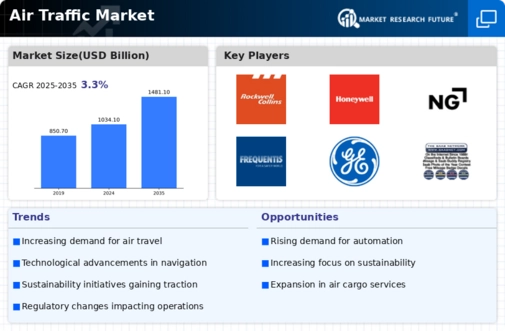Increasing Air Travel Demand
The Air Traffic Market is currently experiencing a surge in air travel demand, driven by rising disposable incomes and a growing middle class in various regions. As more individuals and families opt for air travel for both leisure and business purposes, airlines are expanding their fleets and routes to accommodate this influx. According to recent data, passenger traffic is projected to grow at an annual rate of approximately 4.5% over the next decade. This growth is likely to necessitate enhancements in air traffic management systems to ensure safety and efficiency, thereby propelling advancements within the Air Traffic Market.
Expansion of Low-Cost Carriers
The rise of low-cost carriers (LCCs) is significantly impacting the Air Traffic Market. These airlines offer affordable travel options, making air travel accessible to a broader audience. The competitive pricing strategies employed by LCCs are compelling traditional carriers to reevaluate their pricing models and service offerings. As a result, the overall market is witnessing an increase in passenger volumes, with LCCs capturing a substantial share of the market. This trend is likely to continue, as more consumers prioritize cost-effective travel solutions, thereby driving growth within the Air Traffic Market.
Regulatory Changes and Compliance
The Air Traffic Market is influenced by evolving regulatory frameworks aimed at enhancing safety and efficiency in air travel. Governments and international bodies are implementing stricter regulations regarding air traffic control, environmental standards, and passenger safety. These changes often require airlines and airports to invest in new technologies and systems to comply with regulations. For instance, the implementation of Performance-Based Navigation (PBN) is becoming increasingly common, which optimizes flight paths and reduces fuel consumption. Such regulatory shifts are likely to drive innovation and investment within the Air Traffic Market.
Focus on Sustainability and Environmental Impact
The Air Traffic Market is increasingly prioritizing sustainability and reducing its environmental footprint. Airlines are adopting more fuel-efficient aircraft and exploring alternative fuels to minimize greenhouse gas emissions. Regulatory bodies are also encouraging the adoption of sustainable practices through incentives and guidelines. For instance, the International Air Transport Association (IATA) has set ambitious targets for carbon neutrality by 2050. This focus on sustainability is not only a response to regulatory pressures but also aligns with consumer preferences for environmentally responsible travel options. As such, sustainability initiatives are likely to shape the future trajectory of the Air Traffic Market.
Technological Innovations in Air Traffic Management
Technological advancements are reshaping the Air Traffic Market, particularly in air traffic management systems. Innovations such as artificial intelligence, machine learning, and advanced data analytics are being integrated into air traffic control operations. These technologies enhance decision-making processes, improve safety, and optimize airspace utilization. For example, the introduction of Automatic Dependent Surveillance-Broadcast (ADS-B) technology allows for real-time tracking of aircraft, which is crucial for efficient air traffic management. As these technologies continue to evolve, they are expected to play a pivotal role in the future of the Air Traffic Market.


















Leave a Comment